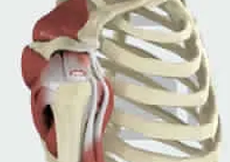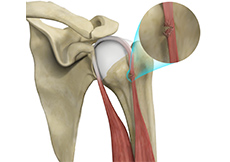- Shoulder Anatomy
- Shoulder Conditions
- Shoulder Procedures
Arthritis of the Shoulder

The term arthritis means inflammation of a joint and is associated with cartilage damage. Cartilage is a cushioned padding lining the bones that make up a joint in order to absorb stress during movement.
Sternoclavicular Arthritis

A rotator cuff is a group of tendons in the shoulder joint that provides support and enables a wide range of motion.
Rotator Cuff Tear

Pain in the shoulder may suggest an injury, which is more common in athletes participating in sports such as swimming, tennis, pitching, and weightlifting.
Shoulder Pain

Shoulder instability is a chronic condition that causes frequent dislocation of the shoulder joint.
Shoulder Instability

Anterior shoulder instability, also known as anterior glenohumeral instability, is a condition in which damage to the soft tissues or bone causes the head of the humerus (upper arm bone) to dislocate or sublux from the glenoid fossa, compromising the function of the shoulder.
Anterior Shoulder Instability

Posterior shoulder instability, also known as posterior glenohumeral instability, is a condition in which the head of the humerus (upper arm bone) dislocates or subluxes posteriorly from the glenoid (socket portion of the shoulder) as a result of significant trauma.
Posterior Shoulder Instability

Posterior shoulder instability, also known as posterior glenohumeral instability, is a condition in which the head of the humerus (upper arm bone) dislocates or subluxes posteriorly from the glenoid (socket portion of the shoulder) as a result of significant trauma.
Shoulder Impingement

Shoulder impingement is the inflammation of the tendons of the shoulder joint. It is one of the most common causes of pain in the shoulder.
Shoulder Fracture

The shoulder is the most flexible joint in the body, enabling a wide range of movements. It is a ball-and-socket joint made up of three bones, namely the humerus (upper arm bone), scapula (shoulder blade) and clavicle.
Clavicle Fracture

The break or fracture of the clavicle (collarbone) is a common sports injury associated with contact sports such as football and martial arts, as well as impact sports such as motor racing.
Glenoid Fractures

Fractures of the glenoid are rare but can occur due to major trauma or during high-energy sports activities.
SLAP Tears

The term SLAP (superior –labrum anterior-posterior) lesion or SLAP tear refers to an injury of the superior labrum of the shoulder.
Shoulder Labral Tear

Traumatic injury to the shoulder or overuse of the shoulder (throwing, weightlifting) may cause the labrum to tear. In addition, aging may weaken the labrum leading to injury.
Shoulder Dislocation

Sports that involve overhead movements and repeated use of the shoulder at your workplace may lead to sliding of the upper arm bone from the glenoid.
Rotator Cuff Pain

The rotator cuff consists of a group of tendons and muscles that surround and stabilize the shoulder joint. These tendons allow a wide range of movement of the shoulder joint across multiple planes.
Shoulder Ligament Injuries

Shoulder ligament injuries are injuries to the tough elastic tissues present around the shoulder that connect bones to each other and stabilize the joint.
Frozen Shoulder

Frozen shoulder, also called adhesive capsulitis, is a condition in which you experience pain and stiffness in your shoulder. The symptoms appear slowly, worsen gradually and usually take one to three years to resolve on their own.
Shoulder Trauma

Shoulder injuries most commonly occur in athletes participating in sports such as swimming, tennis, pitching, and weightlifting.
Baseball and Shoulder Injuries

Shoulder injuries in baseball players are usually associated with pitching. While this overhand throwing activity can produce great speed and distance for the ball, when performed repeatedly, can place a lot of stress on the shoulder. While pitching, the arm is thrown outward and backward to generate speed.
Rotator Cuff Re-tear

Rotator cuff repair is a surgery to repair an injured or torn rotator cuff. A re-tear may occur a few years after surgery due to multiple reasons including aging, a massive previous tear (more than 5cm), fatty degradation of the tendons, inflammatory arthritis, and inappropriate rehabilitation.
Throwing Injuries of the Shoulder

Throwing injuries of the shoulder are injuries sustained as a result of trauma by athletes during sports activities that involve repetitive overhand motions of the arm as in baseball, American football, volleyball, rugby, tennis, track and field events, etc.
Acromioclavicular (AC) Arthritis

The acromioclavicular joint is part of the shoulder joint. It is formed by the union of the acromion, a bony process of the shoulder blade, and the outer end of the collar bone or clavicle.
Shoulder Disorders

The shoulder is the most flexible joint in the body that enables a wide range of movements. Aging, trauma or sports activities can cause injuries and disorders that can range from minor sprains or strains to severe shoulder trauma.
Acromioclavicular Joint Sprains

The collarbone and the shoulder blade are connected by the acromioclavicular joint. This is supported by a strong band of ligaments called the acromioclavicular and coracoclavicular ligaments.
Partial Rotator Cuff Tear

A partial rotator cuff tear is an incomplete tear that involves damage to a part of the tendon. The tear can be at the top, bottom or inner side of the tendon and does not go all the way through the tendon completely.
Shoulder Labral Tear with Instability

The shoulder consists of a ball-and-socket joint formed by the upper end of the humerus (upper arm bone) and a cavity in the shoulder blade called the glenoid.
Proximal Biceps Tendon Rupture

The biceps muscle is the muscle of the upper arm which is necessary for the movement of the shoulder and elbow. It is made of a ‘short head’ and a ‘long head’ which function together.
Rotator Cuff Bursitis

The rotator cuff is a set of muscles and tendons which hold the various bones of the shoulder joint together, providing strength and support.
Multidirectional Instability of the Shoulder

Instability may be described by the direction in which the humerus is subluxated or dislocated from the glenoid. When it occurs in several directions it is referred to as multidirectional instability.
Acromioclavicular (AC) Joint Injuries

The acromioclavicular (AC) joint in the shoulder is very important for shoulder strength, motion, and maintaining shoulder position.
Sternoclavicular Joint Injury

The sternoclavicular joint, commonly called the SC joint, is located between the breastbone (sternum) and the collarbone (clavicle).
Periprosthetic Shoulder Infection

A periprosthetic shoulder joint infection is a very rare, but devastating complication of shoulder replacement surgery characterized by infection of the tissues surrounding your shoulder prosthesis.
Proximal Humerus Fractures

The humerus is the bone that forms the upper arm. It articulates with the glenoid cavity of the scapula (shoulder blade) to form the shoulder joint and with the lower arm bones – the ulna and radius – to form the elbow joint. The proximal humerus is the upper end of the arm bone that forms the shoulder joint. The humerus is broadly divided into the head, neck and shaft region. Just below the head are two processes called the greater and lesser tubercles, which form the sites of attachment for the rotator cuff muscles.
